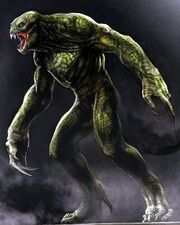| ||||||||||||||||||||||||
| ||||||||||||||||||||||||
| ||||||||||||||||||||||||
Lizape is the common name given to a number of similar creatures found throughout the Frontier. Lizapes are primarily found in ecosystems where reptilian life has flourished and become dominant. Lizapes play the same role in such ecosystems as monkeys and other lesser primates often do in mammalian-based ecologies as developmental precursors to any sentient life on such planets.
Physiology[]
Lizapes share the general body plan of higher-order, arboreal or semi-arboreal creatures: four limbs, at least two of which are capable of grasping and manipulating objects. Smaller, primarily tree-dwelling lizapes have long tails that their ground-dwelling, larger cousins lack. Lizapes are usually knuckle-walking quadrupeds, but some are known to be partially or fully bipedal.
Since lizapes are reptilian, they lack body hair, and their skin ranges from fully scaled to leathery and "pebbled". Unlike lower-order reptiles, they are partially or completely endothermic (warm-blooded), but have problems shedding excess heat after prolonged activity, as they (being reptiles) lack sweat glands.
Poison[]
Lizapes are primarily but not exclusively carnivorous. The saliva of some species of lizape is venomous (5% chance). Depending on the species, the venom may be either neurotoxic (affecting the nervous system, hemotoxic (affecting the blood), or cytotoxic (causing massive cellular breakdown).
Symptoms of the venom depend on it's type. Severity ranges from non-lethal but painful symptoms such as edema (swelling), discoloration, and fever to massive tissue damage and death.
The potency of the venom depends on the size of the lizape. The "rule of thumb" among explorers and other environmental specialists regarding venemous life forms is "the smaller the creature, the stronger the venom". Lizapes are no exception to this rule, as the larger sub-species depend more on their teeth and claws than they do venom to kill their prey.
The various types of lizape venom are being studied for their bio-medical properties by researchers hoping to use them to treat various medical conditions.
Defenses[]
Some species of lizape have hard, sharp horns on their skin. These horns can cause damage to characters trying to grapple or hold a lizape (1d5 damage).
Behavior[]
Being primarily carnivorous, lizapes are frequently more aggressive than monkeys and apes. This, combined with the intelligence and curiosity of a higher-order creature, can make encounters with them potentially very dangerous, depending on size.
Tiny lizapes will often attempt to flee anything significantly larger than they are (such as characters), and will only fight if completely cut off from any means of escape, or if their young are threatened. Larger lizapes are more willing to stand their ground. Cornered, angry, or frightened lizapes will frequently engage in posturing behavior (just as primates do), displaying themselves for maximum intimidation value, hissing and shrieking.
If posturing fails, the lizape will attack viciously for up to 20 turns (two minutes) using it's teeth and claws for 1d10 damage (2d10 in larger specimens). If the lizape has not either driven off or killed the intruder at the end of that time, it will be forced to retreat to physically cool off for at least half an hour (30 minutes/300 turns).
This species submitted by ChrisDonovan. Images are pieces of concept art I found online. The second one was for Amazing Spider-Man and modified by me. The skeleton was created by Brian Richardson.


